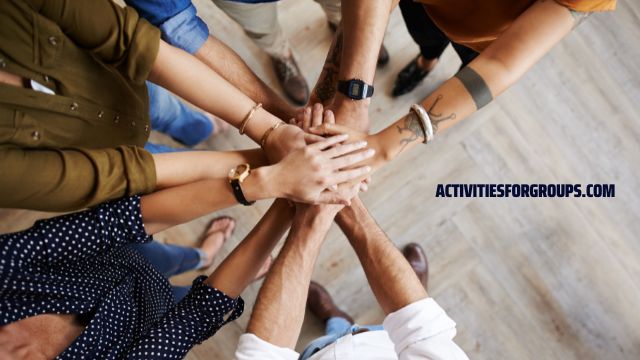Welcome everyone! Today we’ll be discussing group activities for trust-building. We all know the importance of trust in our relationships, both professional and personal. But sometimes it’s hard to know how to build that trust and cultivate a sense of connection within your team or group.
That’s why I’m here – to provide you with some great ideas and strategies for creating an environment where openness and collaboration can thrive.

In this article, I’ll cover several different types of activities that are designed specifically to help foster a sense of trust among members of a group or team. From interactive games to cooperative problem-solving exercises, there are many ways to get people talking, learning more about each other, and ultimately building stronger bonds of friendship and respect.
By the end of this article, you should have plenty of new tools at your disposal that will help create an atmosphere conducive to fostering greater cooperation and understanding between individuals. Let’s dive right in!
Read More: Fun Group Activities That Boost Team Bonding: Preparation Guide.
10 Group Activity Ideas For Fun And Engaging Trust-Building Games
Here are some great ideas that you need to checkout.
| Activity | Preparation | Contribution |
|---|---|---|
| 1. Two Truths and a Lie | Prepare slips of paper for each participant to write down two true statements and one false statement about themselves. | Participants take turns sharing their statements while others guess which is the lie, encouraging open and honest communication. |
| 2. Blindfolded Obstacle Course | Set up an obstacle course and blindfold half of the group. | The sighted participants guide their blindfolded partners through the course, building trust and communication skills. |
| 3. Trust Fall | Set up a safe environment and have participants pair up. One person stands behind the other with their arms crossed, ready to catch them. The person in front falls backward, trusting their partner to catch them. | Participants build trust in each other by taking a risk and relying on their partners to support them. |
| 4. Human Knot | Participants stand in a circle and grab hands with someone across from them. They then work together to untangle themselves without letting go of their hands. | Participants must communicate and work together to solve the problem, building trust and cooperation. |
| 5. Scavenger Hunt | Plan a scavenger hunt with clues and tasks that require teamwork to complete. | Participants work together to solve clues and complete tasks, building trust and collaboration. |
| 6. Group Storytelling | Participants take turns adding to a collective story. | Participants must trust each other to build on each other’s ideas and create a cohesive story. |
| 7. Marshmallow Challenge | Provide each group with a set of materials (such as spaghetti and marshmallows) and challenge them to build the tallest structure possible. | Participants must communicate and collaborate to create a successful structure, building trust, and teamwork skills. |
| 8. Minefield | Set up an obstacle course with objects scattered throughout. Participants are blindfolded and must navigate through the course without touching any of the objects. | Participants must rely on their partners to guide them safely through the course, building trust and communication skills. |
| 9. Team Building Board Games | Choose board games that require teamwork and communication, such as Pandemic or Forbidden Island. | Participants work together to win the game, building trust and collaboration. |
| 10. Mirror Exercise | Participants pair up and take turns being the leader and follower. The leader makes slow, deliberate movements and the follower mirrors their actions. | Participants must trust and communicate with each other to successfully mirror movements, building trust and rapport. |
What Is Trust-Building?
Trust-building is an absolutely essential part of any relationship. It’s so integral to a strong bond that without it, there can be no real connection or understanding between two people. In its simplest terms, trust-building means developing and maintaining a sense of trustworthiness with each other.
It involves creating an environment in which individuals feel comfortable expressing their true selves while also allowing the opportunity for others to do the same. This type of atmosphere encourages communication, collaboration, and empathy – all key components of a trusting relationship.
The power of trust-building exercises cannot be understated; they have the ability to strengthen existing relationships and create new ones as well. Through these activities, we can learn more about ourselves and those around us – deepening our connections and building bridges beyond what was previously thought possible. Let’s take a look at the benefits of trust-building exercises…
Benefits Of Trust-Building Exercises

Trust-building exercises can have a plethora of benefits for groups and organizations. Here are some key points to consider:
- Increased group cohesiveness
- Improved collaborative environment
- Strengthened relationships between team members
- Enhanced motivation in the workplace
These activities help create an atmosphere where individuals feel safe to express themselves openly, without judgment or criticism from others. This encourages communication among all members of the group, allowing them to share ideas freely and build trust with each other.
As a result, teams become more cohesive and work better together as everyone is on the same page about goals and expectations. Furthermore, when team members start to trust one another it leads to stronger relationships which yield greater productivity in terms of creative problem-solving and collaboration. Lastly, by engaging in trust-building exercises team morale is boosted as everyone feels valued and supported within their organization.
The success of any organization relies heavily on its ability to foster strong connections between its employees. Trust-building exercises are essential tools that can be used to develop a healthy working environment while strengthening relationships between teammates.
By investing time into these activities, leaders can reap many rewards such as increased group cohesiveness, improved collaborative environment, strengthened relationships between team members, and enhanced motivation in the workplace.
With this knowledge, it is clear that effectively implementing trust-building exercises can lead to great strides being made toward achieving organizational objectives.
Types Of Trust-Building Group Activities

Trust-building activities are a great way to get group members to know each other better and build trust. These types of activities can range from simple icebreakers to more complex tasks that involve problem-solving or communication. Here are some popular examples:
Scavenger hunts are great for fostering collaboration among participants as they work together in teams to find items scattered throughout the room.
Role-playing is another effective option; it allows team members to practice communicating with one another in various scenarios while building trust. Trust falls, trust walks, and silent conversations also provide opportunities for groups to learn how to rely on one another’s support and understanding.
These activities not only bring people closer together but help create an environment where everyone feels safe sharing their thoughts and feelings without fear of judgment or ridicule. They can also be adapted to any size or type of group, making them easily customizable for different needs or objectives.
Icebreaker Games
Icebreaker games are like the first steps of a journey – they provide an opportunity for people to get to know each other, break through any barriers that may exist between them, and create a foundation of trust. Icebreakers can be anything from group introductions activities, icebreaker questions, or team introduction activities.
One great example is ‘Two Truths and a Lie’, where every person in the group introduces themselves by saying two true facts about themselves and one false fact. Everyone else then has to guess which one of these three statements is false. This not only allows everyone an easy way to learn more about each other but also helps build relationships as well as trust among members of the group.
Another popular game is called ‘Zip Zap Zop’. The rules are simple: one person starts off by saying “zip”, the next person says “zap” followed by someone saying “zop”. Then it goes back around with another participant stating something different such as “boing”, while everyone follows this pattern until someone messes up and gets eliminated from the game.
Not only does this activity help participants become familiar with names within the group, but it also encourages them to pay attention and builds quick-thinking skills too!
As we wrap up our discussion on icebreaker activities, let us move on to discussing team-building games that bring groups together even further.
Team Building Games
Team-building games are an excellent way to build trust and foster team bonding. These activities provide a fun, relaxed atmosphere for teams to interact, communicate and bond with one another. There is no better way to create strong relationships between members of a group than through these types of activities.
Some popular trust-building exercises include balancing on each other’s feet while blindfolded, having individuals lower themselves over the edge of a rope while others hold it secure below them, or having different members of the group stand in a circle and pass objects around without breaking contact. Each game has its own unique rules that must be followed by all participants in order to ensure safety and success within the activity.
Although there are many more traditional trust-building activities available, group activities also offer great opportunities for team bonding.
Activities such as scavenger hunts, outdoor obstacle courses, and trivia contests can help bring out teamwork skills among groups who may not always have much practice working together as a cohesive unit. By providing challenges that require collaboration from everyone involved, it can become easier for individual players to learn how their roles work together toward achieving common goals.
Furthermore, when done correctly these activities can quickly break down barriers between teammates while fostering stronger bonds between them too!
In short, team-building games are essential tools for organizations looking to cultivate greater levels of trust and camaraderie among their staff members. From classic trust-building exercises to creative group activities designed specifically for team bonding purposes – there is something available for every type of organization’s needs. With the right combination of tasks and objectives set forth by facilitators leading these sessions – any team should come away feeling closer-knit afterward! Now onto communication exercises…
Communication Exercises
Now that your group has experienced some team-building games, it’s time to build trust with communication exercises. These activities are designed to get your group comfortable communicating openly and honestly while also tapping into the power of teamwork.
Through these exercises, you can help foster a sense of understanding within your group dynamics and create an environment where everyone feels like they can share their ideas without judgment.
When it comes to trust-building activities, cooperative tasks are essential for helping members learn how to depend on one another. This could be anything from working together in smaller groups to complete a task or sharing stories about past experiences as a way to open up dialogue between members. It is important that each person takes part in the activity so everyone feels heard and valued by the group.
No matter what type of exercise you choose, make sure all participants have a chance to express themselves freely and practice active listening skills when interacting with others.
By engaging in meaningful conversations during these activities, your group will develop stronger connections based on mutual respect and trust. From there, move on to problem-solving strategies – which focus on honing critical thinking skills – and you’ll be ready for any challenge!
Problem-Solving Strategies
Incredible problem-solving strategies are an absolute must for any group looking to build trust. Making decisions as a team can be incredibly difficult, but with the right skills and techniques, everyone can learn how to work together more effectively.
Brainstorming is one of the most powerful tools when it comes to solving problems in groups. It’s all about sharing ideas, generating solutions, and getting creative! By using brainstorming techniques, individuals in the group will feel heard and respected – plus they’ll gain valuable decision-making experience.
Conflict resolution is also key to successful teamwork. Without effective conflict management, tensions can quickly get out of hand! Group dynamics play a huge role here: Everyone needs to take responsibility for their part within the group setting by listening carefully and remaining respectful during disagreements.
With these tactics under your belt, you’ll have all the confidence necessary to tackle any creative thinking challenge that may come your way!
Creative Thinking Challenges
Now that we’ve discussed problem-solving strategies, let’s turn our attention to ways of developing creative thinking skills in a group setting. Creative-thinking challenges are great for encouraging team thinking and collaboration. Here are some ideas to get you started:
One activity is called ‘Chain Reaction’. In this exercise, each person takes turns adding one piece at a time to build an idea or story together as a team. Each participant contributes something new until the end result is reached. This can be used for brainstorming exercises or just for fun!
Another creativity exercise involves creating something from nothing. Give everyone a blank sheet of paper and challenge them to come up with the most imaginative thing they can create within a set amount of time (say 5 minutes). It could be anything – a drawing, poem, song lyrics, etc.
Afterward, share your creations with each other and discuss what inspired you!
These activities provide an opportunity to explore different perspectives on how best to approach any given situation while exercising creative muscles along the way. They also encourage constructive dialogue between members and help build trust among team members. So why not give these creative-thinking challenge ideas ago today?
Frequently Asked Questions {FAQs}
What Is The Best Way To Measure The Success Of Trust-Building Exercises?

Measuring the success of trust-building exercises can be a tricky business. When it comes to assessing and evaluating how successful something like this is, there are no clear-cut answers – it depends on the context and situation at hand. That being said, there are some methods that can prove useful in measuring how effective these exercises have been.
One way of determining if trust-building activities have achieved their goal is by looking for evidence that participants feel more comfortable opening up about themselves or taking risks with others after engaging in such activities.
This could involve asking questions related to what happened during the activity and encouraging honest feedback in order to gain an understanding of whether any real progress was made. Additionally, observing changes in body language or behavior between individuals who participated in a trust-building exercise may provide insight into whether they developed greater trust in one another as a result.
Another method for gauging success when it comes to building trust is keeping track of progress over time. Initial assessments should take place shortly after carrying out the activity while follow-up checks should occur regularly afterward; this allows facilitators to monitor changes in attitude or outlook within group members and determine if any meaningful development has occurred. It’s important to remember that trust isn’t built overnight; oftentimes, smaller gains will accumulate over time until eventually leading to bigger successes further down the line.
Ultimately, when facilitating group activities aimed at strengthening relationships through increased levels of trust, it’s essential for leaders to consider ways of properly assessing whether or not objectives were met.
By using certain indicators such as participant feedback and long-term tracking systems, measurable results can be obtained which accurately represent just how much impact each exercise had on creating deeper connections among those involved
How Long Should A Trust-Building Activity Last?
When it comes to trust-building activities, one of the most common questions asked is how long should a trust-building activity last. This can be a tricky question as there isn’t an exact answer – because each group, and their particular dynamics and needs, will affect the amount of time that’s best for any given exercise. But there are some general guidelines facilitators should keep in mind when deciding on the length of trust-building exercises:
- Consider allocating at least 15 minutes per exercise; this gives participants enough time to become comfortable with the task or game they’re playing while also allowing them to build relationships within their team.
- If you have more people participating in a single session, then you may need to extend the duration depending on your goals for the activity.
- The type of activity is also important – if it’s more task-oriented than relationship-building-oriented, you’ll likely need less time than if you were facilitating something aimed solely at increasing interpersonal understanding.
- Lastly, consider participant energy levels; if they seem tired or disinterested after a certain period of time, it might be best to move on to another activity or break earlier than planned.
In summary, no two groups will require exactly the same amount of time for trust-building activities. Being mindful of individual circumstances like group size and goal setting helps ensure success by providing guidance on how long an exercise should take place. Ultimately though, it’s up to the facilitator to use their own judgment and decide what works best for each unique situation!
How Do I Know If Trust-Building Activities Are Appropriate For A Group?

When it comes to trust-building activities, many people wonder how they can know if the activity is appropriate for a group. To answer this question, there are several factors that need to be considered. Firstly, it’s important to evaluate the relevance of the activity in terms of developing trust amongst participants. The activity should also be suitable for the group – does it fit their size and dynamic? Lastly, you’ll want to assess its appropriateness based on the context in which it will take place.
For example: when I was facilitating an experiential learning workshop with a team from a tech start-up, we incorporated some trust-building exercises around communication and collaboration. We had discussed at length prior what kind of activities would work best for their situation; they were mostly introverts working together remotely as a small but growing team.
We decided that icebreakers such as ‘Two Truths and a Lie’, or other structured tasks like blindfolded problem-solving could help them learn more about each other while building mutual respect and understanding – all within a reasonable time frame of 30 minutes per exercise.
To ensure that your trust-building activities are both relevant and effective:
- Assess whether the activities have strong links to improving trust between members;
- Establish if they match the size and dynamics of your group;
- Consider if they’re suitable given any environmental restrictions/limitations (e.g., space, noise).
By evaluating these three points thoroughly before introducing any trust-building activity into your session, you’ll be able to make sure that everyone involved has an enjoyable experience whilst still achieving positive outcomes in terms of fostering better relationships through teamwork and communication.
How Can I Ensure That Everyone In The Group Is Participating In The Exercises?
When it comes to group activities, ensuring everyone is participating can be challenging. It’s important that all members of the group are engaged in order for trust-building exercises to be effective. There are a few different ways you can increase participation levels and make sure everyone is on board with the activity.
One way is to come up with creative ideas that will draw people into the exercise. This could involve using props or other tools to illustrate your point, or incorporating elements of team building games that require collaboration between participants.
By providing interesting, engaging activities, everyone in the group will become invested in what’s going on and feel more comfortable taking part in the process.
Another key factor when it comes to increasing participation is understanding the dynamics of each individual within the larger team. If someone seems hesitant to participate or isn’t responding well to certain activities, take some time out from the session and talk one-on-one about their thoughts and feelings related to trust-building activities.
Showing an interest in their personal experience can help create an atmosphere where they’re more likely to open up during exercises and get involved with others in the group.
It’s also helpful as a facilitator to check in periodically throughout any type of group activity and ask how everyone’s feeling about it – this gives individuals an opportunity to voice any concerns they may have while still maintaining a sense of openness and inclusion among those present.
With these tactics at hand, you’ll be able to ensure your trust-building activities are fun, interactive and successful!
How Can I Make Sure That Trust-Building Activities Remain Fun And Engaging?

When it comes to trust-building, fun, and engagement in activities are key. Whether you’re running icebreakers or team challenges, there are a few things that can help ensure everyone remains engaged:
- Incorporate themes into the activities – this will make them more interesting for participants;
- Create a relaxed atmosphere with plenty of laughter and camaraderie;
- Have meaningful conversations about the exercises afterward to reinforce learning.
As a facilitator, it’s important to create an environment where people feel comfortable being themselves and taking risks without fear of judgment or failure. Icebreakers and communication exercises can be great ways to start off as they let people get to know each other better while having some laughs along the way.
Trust games such as passing something around the circle blindfolded, building puzzles together as teams or problem-solving activities like forming a human bridge can help build relationships between members within the group by showing how trust between individuals creates success for the whole team.
It’s also essential that all activities remain relevant to what you’re trying to achieve – so if your goal is trust-building then any tasks should reflect that focus rather than getting distracted by unrelated topics or tasks which don’t contribute towards achieving your desired outcome.
Having different levels of difficulty included in your selection of exercises helps keep everyone motivated throughout their session too! Ultimately, making sure everybody gets involved, has fun, and feels supported during these exercises will lead to stronger bonds among members of the group and improved overall results when participating in future trust-building activities.
Conclusion
Trust-building exercises are an integral part of any successful group, as they help to create a sense of unity and cohesion. It’s important that we ensure these activities remain fun and engaging for everyone in the group, while also measuring their effectiveness.
To do this, it’s essential to consider how long each activity will last, what type of activities are appropriate for the team, and how best to involve all members of the group.
As facilitators, our role is to make sure that everybody feels included in the trust-building process. We should strive to create a safe space where every member can feel comfortable expressing themselves without judgement or fear.
Additionally, by using techniques such as alliteration and repetition within our instructions during these sessions, we can increase engagement levels among participants and encourage them to be more open with one another.
Overall, trust-building activities play an invaluable role in helping teams work together better than ever before – but only if done effectively! By taking into account factors like timing, appropriateness and participation from everyone involved, I’m confident that your group will soon find itself stronger than ever before thanks to strong bonds created through trust-building exercises.




Leave a Reply